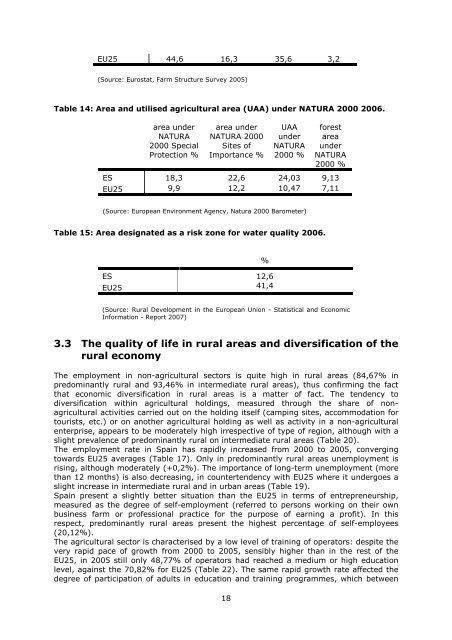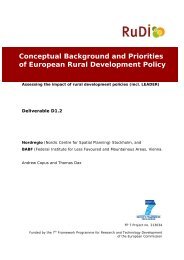Country profile on rural characteristics Spain - RuDI
Country profile on rural characteristics Spain - RuDI
Country profile on rural characteristics Spain - RuDI
- No tags were found...
Create successful ePaper yourself
Turn your PDF publications into a flip-book with our unique Google optimized e-Paper software.
EU25 44,6 16,3 35,6 3,2(Source: Eurostat, Farm Structure Survey 2005)Table 14: Area and utilised agricultural area (UAA) under NATURA 2000 2006.area underNATURA2000 SpecialProtecti<strong>on</strong> %area underNATURA 2000Sites ofImportance %UAAunderNATURA2000 %forestareaunderNATURA2000 %ES 18,3 22,6 24,03 9,13EU25 9,9 12,2 10,47 7,11(Source: European Envir<strong>on</strong>ment Agency, Natura 2000 Barometer)Table 15: Area designated as a risk z<strong>on</strong>e for water quality 2006.ES 12,6EU25 41,4%(Source: Rural Development in the European Uni<strong>on</strong> - Statistical and Ec<strong>on</strong>omicInformati<strong>on</strong> - Report 2007)3.3 The quality of life in <strong>rural</strong> areas and diversificati<strong>on</strong> of the<strong>rural</strong> ec<strong>on</strong>omyThe employment in n<strong>on</strong>-agricultural sectors is quite high in <strong>rural</strong> areas (84,67% inpredominantly <strong>rural</strong> and 93,46% in intermediate <strong>rural</strong> areas), thus c<strong>on</strong>firming the factthat ec<strong>on</strong>omic diversificati<strong>on</strong> in <strong>rural</strong> areas is a matter of fact. The tendency todiversificati<strong>on</strong> within agricultural holdings, measured through the share of n<strong>on</strong>agriculturalactivities carried out <strong>on</strong> the holding itself (camping sites, accommodati<strong>on</strong> fortourists, etc.) or <strong>on</strong> another agricultural holding as well as activity in a n<strong>on</strong>-agriculturalenterprise, appears to be moderately high irrespective of type of regi<strong>on</strong>, although with aslight prevalence of predominantly <strong>rural</strong> <strong>on</strong> intermediate <strong>rural</strong> areas (Table 20).The employment rate in <strong>Spain</strong> has rapidly increased from 2000 to 2005, c<strong>on</strong>vergingtowards EU25 averages (Table 17). Only in predominantly <strong>rural</strong> areas unemployment isrising, although moderately (+0,2%). The importance of l<strong>on</strong>g-term unemployment (morethan 12 m<strong>on</strong>ths) is also decreasing, in countertendency with EU25 where it undergoes aslight increase in intermediate <strong>rural</strong> and in urban areas (Table 19).<strong>Spain</strong> present a slightly better situati<strong>on</strong> than the EU25 in terms of entrepreneurship,measured as the degree of self-employment (referred to pers<strong>on</strong>s working <strong>on</strong> their ownbusiness farm or professi<strong>on</strong>al practice for the purpose of earning a profit). In thisrespect, predominantly <strong>rural</strong> areas present the highest percentage of self-employees(20,12%).The agricultural sector is characterised by a low level of training of operators: despite thevery rapid pace of growth from 2000 to 2005, sensibly higher than in the rest of theEU25, in 2005 still <strong>on</strong>ly 48,77% of operators had reached a medium or high educati<strong>on</strong>level, against the 70,82% for EU25 (Table 22). The same rapid growth rate affected thedegree of participati<strong>on</strong> of adults in educati<strong>on</strong> and training programmes, which between18



